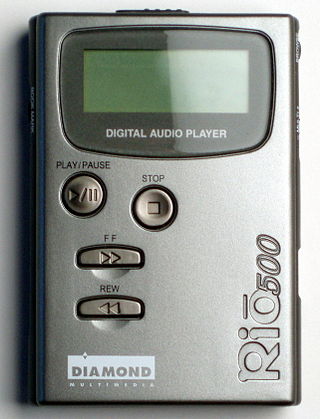
MiniDisc (MD) is an erasable magneto-optical disc-based data storage format offering a capacity of 60, 74, and later, 80 minutes of digitized audio.
iRiver, stylized IRIVER and formerly as iriver, is a South Korean consumer electronics division owned by Dreamus which markets music and other accessories in its domestic market.

The Personal Jukebox was the first consumer hard drive-based digital audio player. Introduced in 1999, it preceded the Apple iPod, SanDisk Sansa, and other similar players. It was designed and developed by Compaq Research starting in May 1998. Compaq did not release the player themselves, but licensed the design to HanGo Electronics Co., Ltd. of South Korea.

A portable audio player is a personal mobile device that allows the user to listen to recorded audio while mobile. Sometimes a distinction is made between a portable player, battery-powered and with one or more small loudspeakers, and a personal player, listened to with earphones.

ZEN is a series of discontinued portable media players designed and manufactured by Creative Technology Limited. The players evolved from the NOMAD brand through the NOMAD Jukebox series of music players, with the first separate "ZEN" branded models released in 2004. The last Creative Zen player, X-Fi3, was released at the end of 2011.

A portable media player (PMP) is a portable consumer electronics device capable of storing and playing digital media such as audio, images, and video files. The data is typically stored on a compact disc (CD), Digital Versatile Disc (DVD), Blu-ray Disc (BD), flash memory, microdrive, SD cards or hard drive; most earlier PMPs used physical media, but modern players mostly use flash memory. In contrast, analogue portable audio players play music from non-digital media that use analogue media, such as cassette tapes or vinyl records.

Diamond Multimedia is an American company that specializes in many forms of multimedia technology. They have produced graphics cards, motherboards, modems, sound cards and MP3 players, however the company began with the production of the TrackStar, a PC add-on card which emulated Apple II computers. They were one of the major players in the 2D and early 3D graphics card competition throughout the 1990s and early 2000s.

iAUDIO is the brand name for a range of portable media players produced by Korean consumer electronics and software corporation Cowon Systems, Inc.

Lyra is a series of MP3 and portable media players (PMP). Initially it was developed and sold by Indianapolis-based Thomson Consumer Electronics Inc., a part of Thomson Multimedia, from 1999 under its RCA brand in the United States and under the Thomson brand in Europe. There were also RCA/Thomson PMPs without the Lyra name, such as the RCA Kazoo (RD1000), RCA Opal and RCA Perl. In January 2008, Thomson sold its Consumer Electronics part including the RCA brand and Lyra line to AudioVox. RCA-branded PMPs are still being made today in its domestic market but no longer under the Lyra name. The Lyra was an early pioneer in digital audio players, although in later years most of its output were OEM products.

Rio was the brand name of a line of digital audio players and related audio products. It was a pioneer of the DAP industry when it released "Diamond Rio" player in 1998 that was the impetus for an infamous lawsuit. Various music players were released until Rio came to an end in 2005.

Yepp was Samsung Electronics' digital audio player brand until Samsung decided to retire most of their family brands in February 2011. From then on, their MP3 players were simply branded "Samsung" worldwide until they discontinued all of them in late 2013. The brand included a wide range of hard-drive based as well as flash-memory based players. The name is claimed to be an acronym for "young, energetic, passionate person".
The Gigabeat was a line of digital media players by Toshiba.

The RioForge is a digital audio player that was produced by Rio Audio, Inc. While it competed in the same market as Apple Inc's iPod mini, it is considerably different as it plays from internal memory, SD card, or FM broadcast and runs on a single AAA battery.

The Rio 500 is considered the first of the Second Generation MP3 digital audio player, and was produced by Diamond Multimedia. It shipped September 22, 1999. The Rio 500 was the successor of the Rio PMP300, and provided a number of user requested features. There were many reviews of the Rio 500.

SanDisk has produced a number of flash memory-based digital audio and portable media players since 2005. The current range of products bear the SanDisk Clip name, a line of ultraportable digital audio players. SanDisk players were formerly marketed under the Sansa name until 2014.

The Archos Jukebox is a series of Archos portable audio players from 2000 through 2002.

The Nokia 2700 classic is a Nokia quad-band GSM cell phone. It has a camera, FM radio, bluetooth connectivity, multimedia playback, and several internet-based applications. It is assembled in Romania.

Recording Indus. Ass’n of Am. v. Diamond Multimedia Sys., Inc., 180 F.3d 1072, 51 U.S.P.Q.2d (BNA) 1115 was a case decided by the United States Court of Appeals for the Ninth Circuit in 1999. The court applied the Audio Home Recording Act to the Rio digital audio player manufactured by Diamond Multimedia, concluding that the Rio was not a "digital audio recording device" under that statute.
















